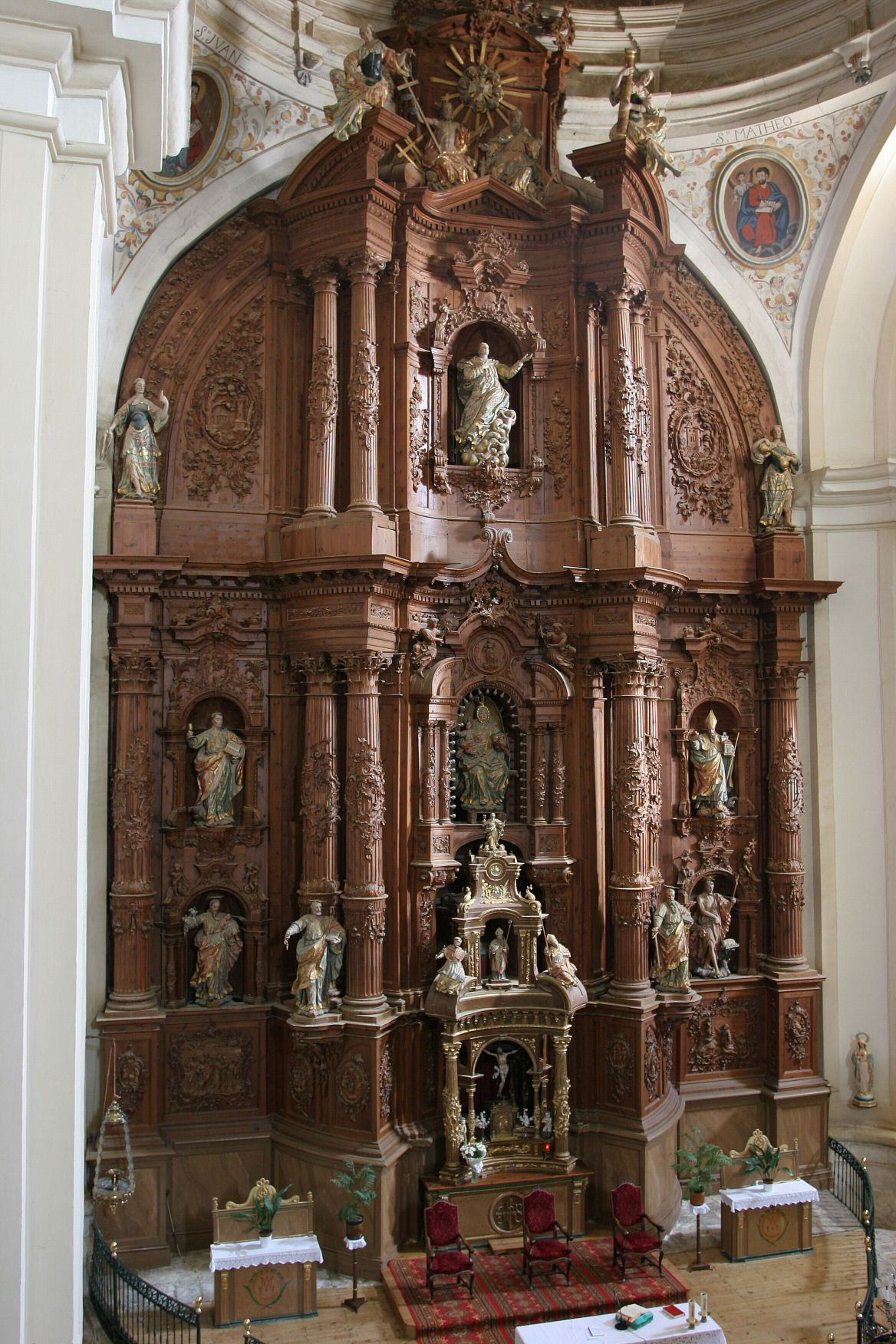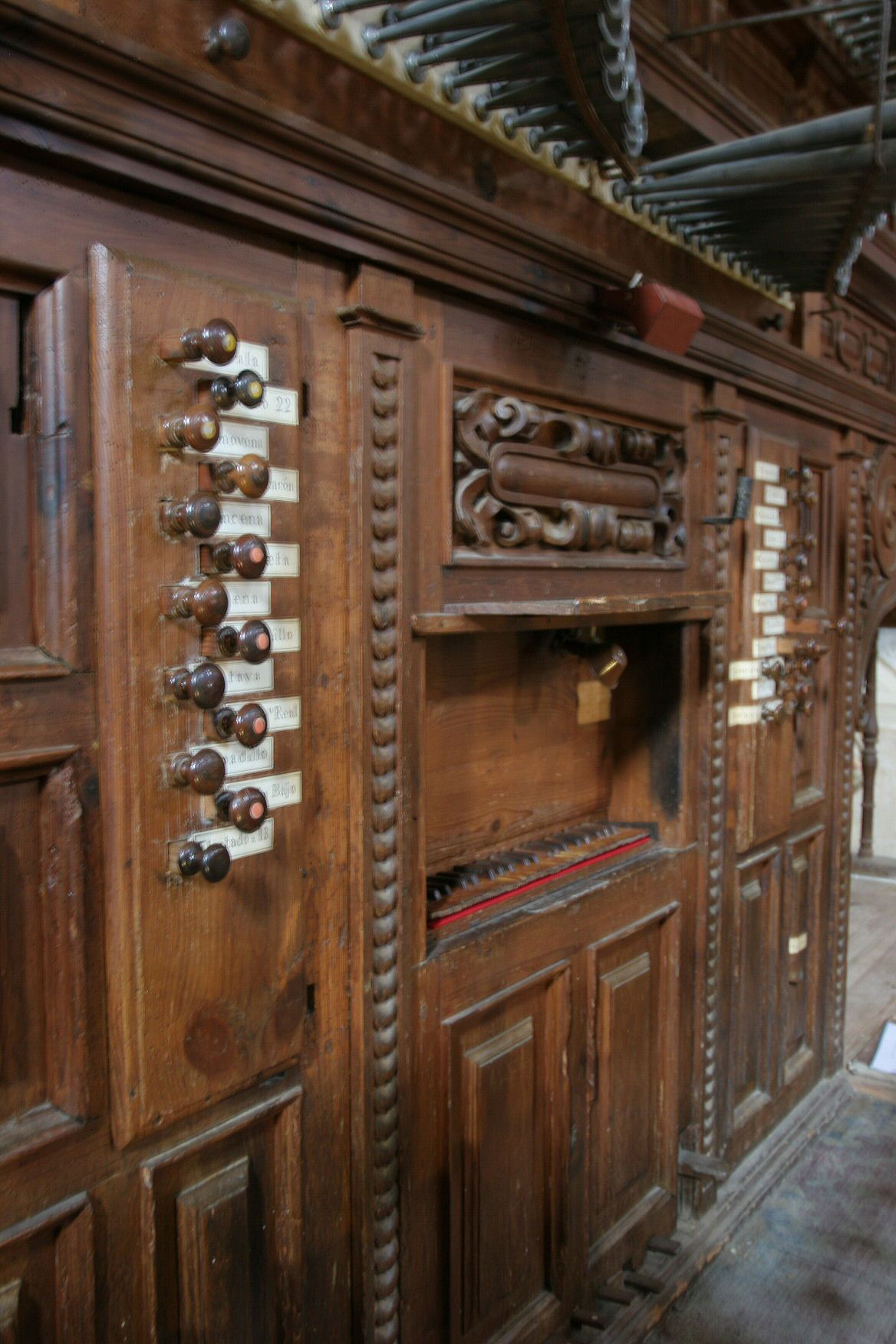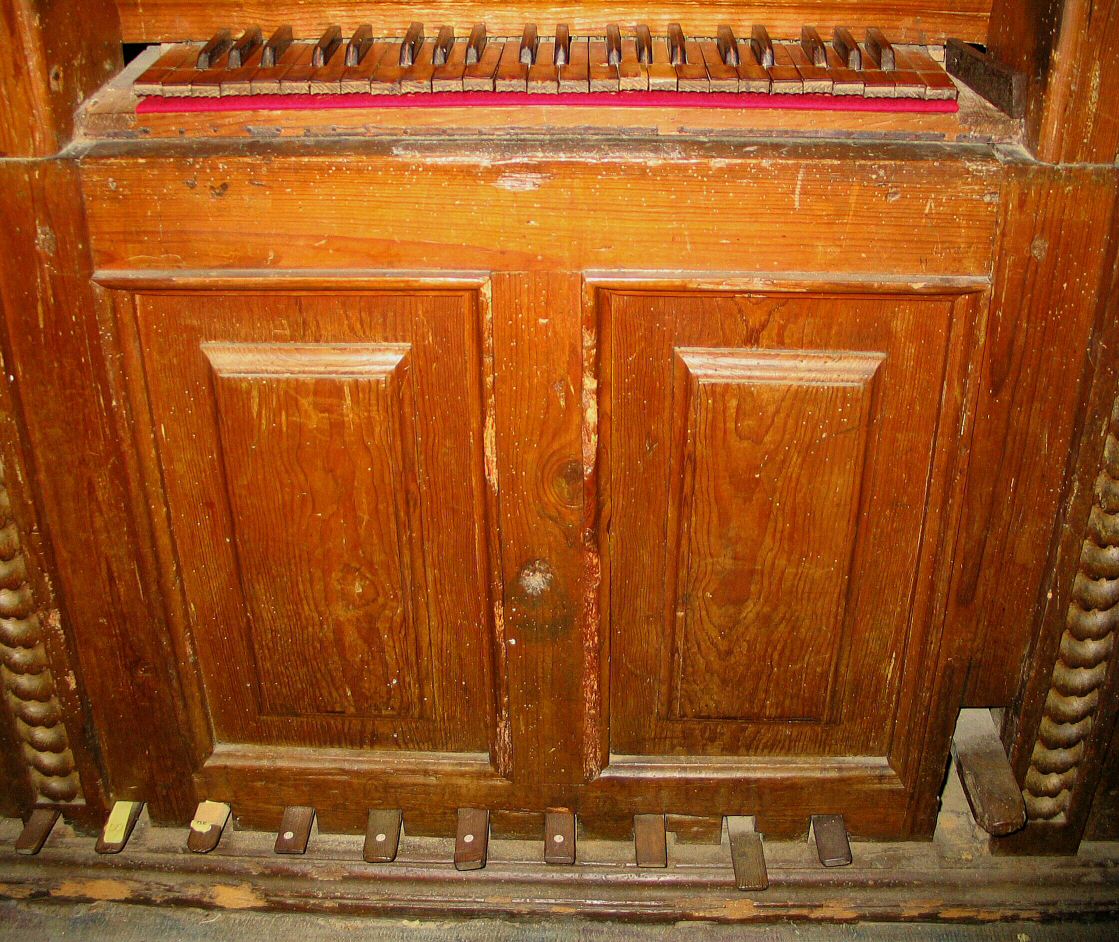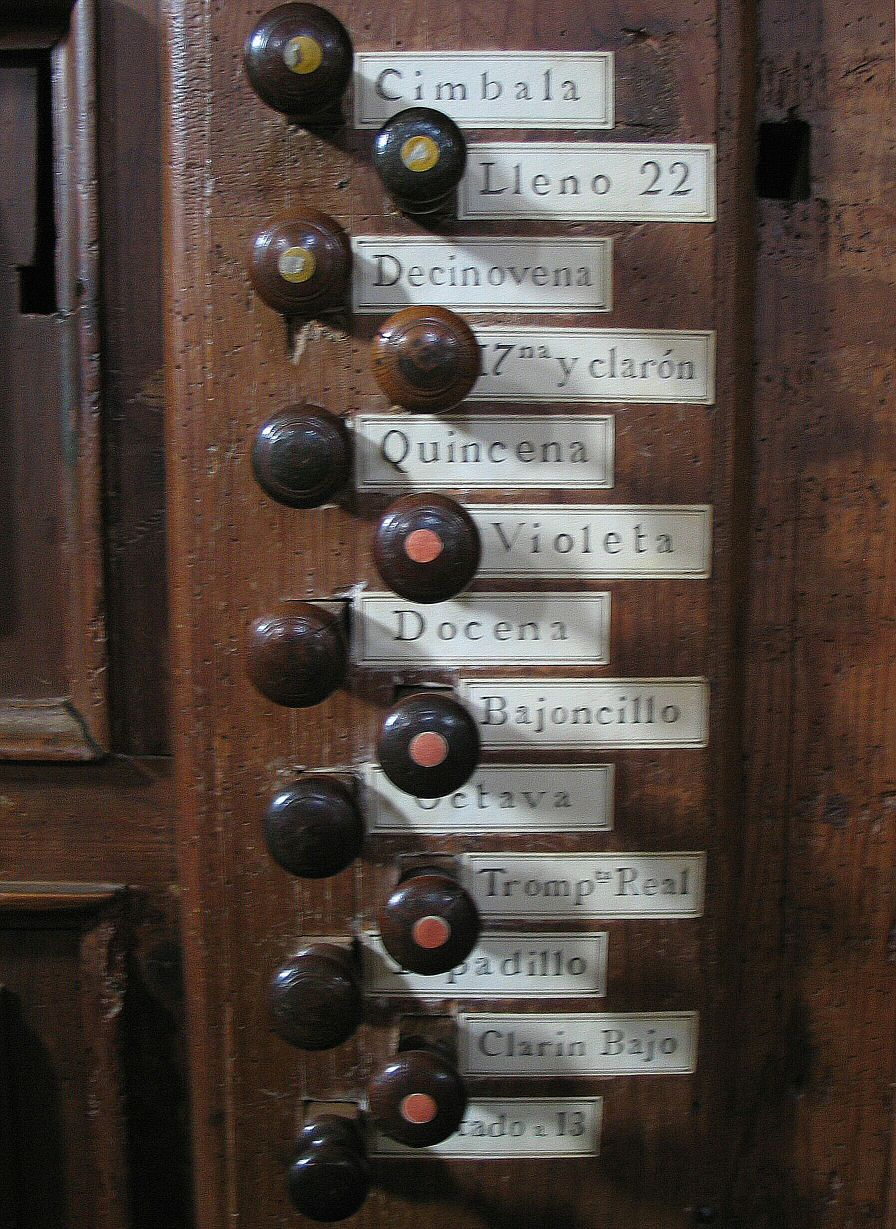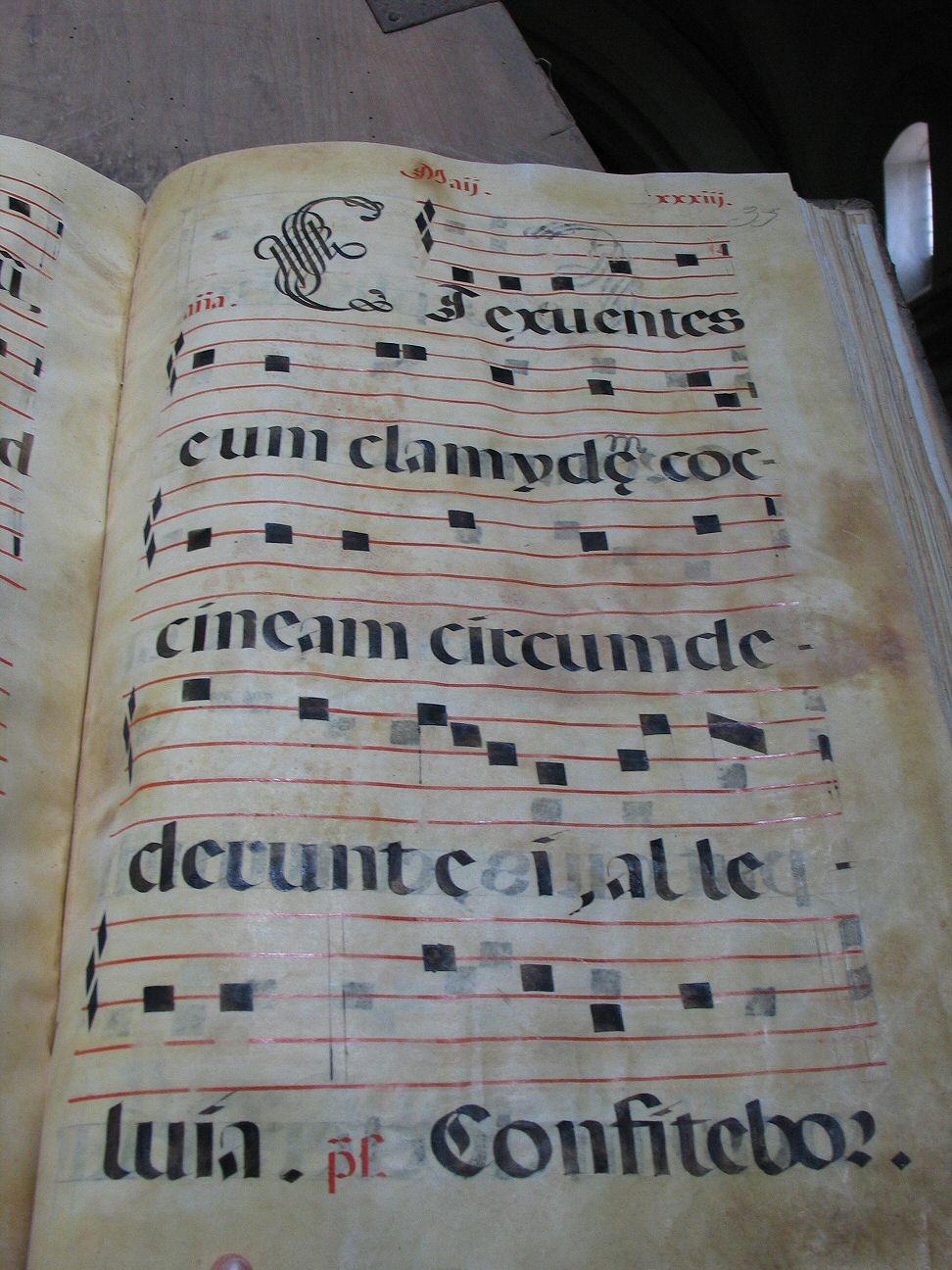1691/1788 García-Martínez Organ
Iglesia de San Miguel, Frechilla/Palencia, Castilla y León, Spain
Short Introduction and History
The organ case was built in 1684 by Mateo de Lago, a joiner from Frechilla. It is constructed of pine.
Between 1687 and 1691, Juan García, an organist and organ-builder also from Frechilla, built an instrument of which the fluework survives unaltered in the present organ. This instrument had one divided keyboard of 42 notes, with a short bottom octave.
In 1718, the Cascabeles (bells) with their accompanying angels were added.
In 1730, the gallery on which the organ now stands was built high up on the north side of the church, near the west end. The organ was moved to the gallery by Antonio Rodríguez Carvajal from Sahagún. He added three notes to the treble of each register, giving the instrument its present compass of 45 notes with a short bottom octave. He also added three new stops, namely the Címbala, the Corneta and the vertical Trompeta Real which stands at the back of the case. He also added the Pájaros (nightingale), two sets of Tambores (drums, each consisting of two pipes so as to produce a dissonant rolling effect). Finally, he added the angel and trumpet still to be seen at the top of the case.
In 1788, the organ was enlarged and restored by Antonio and Tomás Ruiz Martinez, organ-builders from Torquemada. They were also responsible for building the largest instrument in the province of Palencia (organ at Amusco dating from 1786-7) and also the largest in the neighbouring province of Valladolid (organ at La Seca dating from 1792). The Frechilla organ was provided with new bellows, in which four feeder bellows, driven by a single handle, feed a large multi-fold diagonal bellows. This is still in working order. He also replaced the wind trunk, soundboards, stop action, suspended tracker action, and keyboard. The latter is of boxwood. To bring the organ into line with the fashion of the day, he added the six half-registers of chamade reeds.
The organ was cleaned and the bellows repaired in 1832, 1886 and 1911. By the end of the early 1950’s, it had become silent.
In 1980, a programme of repair was started on the organ by the French organ builder Daniel Birouste and the organist Francis Chapelet. The bellows were repaired, the organ was again cleaned, and a small number of missing pipes replaced in the trebles of the Lleno and the Címbala. The bass of the vertical Trompeta real, which had also disappeared, was renewed. Otherwise the organ retains its original pipework dating from 1691, 1730 and 1788, together with the 1788 wind system, soundboards and action, which remains light, responsive, and relatively quiet. The organ was fully operational again by 1983, complete with an electric blower which feeds the diagonal bellows, but the instrument remains fundamentally in its 1788 condition in that since then it has never been fully dismantled.
The combination of largely seventeenth-century fluework, eighteenth-century reeds of the highest quality complete with original shallots and tongues, and the superb acoustic of the tall church, produces a sound of great magic.
Text by Nicolas James, England
The church room has a wet acoustics of up to 4 seconds of reverberation.
See Location in Googlemaps
Recording technique
The organ was recorded in August 2005 with 48 kHz, 24 bit, multi-channel for Hauptwerk 3, using the multi-release technique introduced by OrganArt. The stops were recorded with multiple release levels for short and long key attacks for optimal acoustical mapping.
Thanks
This project is especially dedicated to organist Francis Chapelet, France, for all his great efforts concerning the restoration of Spanish historic organs.
I would like to thank the parish of San Miguel, Frechilla, for enabling and supporting this project. Special thanks to Nicolas James, Southampton, for setting up all the contacts, translations and local help and Michael Walther, organ builder, France, for endless hours of tuning and small scale restoration.
Last but not least special thanks to my wife, who assists all projects and is responsible for the photo documentation.
Virtual Console
Specification
Organ temperament:
Tartini-Vallotti like tuning at a1=432 Hz
Tuning table (Cents)
| c | c# | d | dis | e | f | fis | g | g# | a | a# | h |
| 0 | 88 | 197 | 302 | 398 | 497 | 590 | 700 | 788 | 898 | 1000 | 1095 |
Manual compass:
C, D, E, F, G, A - c3 (short octave)
Pedal compass:
Do, Re, Mi, Fa, So, La (C, D, E, F, G, A)
Stop list:
Manual Bajos (C,D,E,F,G,A,A#–c1)01. Flautado (8') |
Manual Tiples (c#1–c3)01. Flautado (8') |
CouplersPedal stubs fixed coupled Registration AidsCascabeles Bajos (Bells), |
Requirements
Loaded Version |
Memory Requirements 3) |
Processor Speed |
|
16-bit, compressed1) |
1100 MB |
≥ 2 GHz DualCore 2) |
|
20-bit, compressed |
1650 MB |
≥ 2 GHz DualCore 2) |
|
24-bit, compressed |
2000 MB |
≥ 2 GHz DualCore 2) |
1) Lossless compression (no loss of sound quality!)
2) Recommended: Dual-Core, 4 GByte main memory
3) To load this organ into Hauptwerk you will need enough free memory in your computer, due to the amount of playable stops, not including the operating system or any other programs that may be running!
We recommend a professional audio card (e.g. RME-Series) and a studio headphone (e.g. AKG Reference Headphone K701, K712) for optimal sound and room impression.
Demos
The following demo pieces were recorded with the Hauptwerk Advanced Edition software and the virtual organ sample set, with no additional effects processing.
Live recorded demos by Fabio Mancini, Milano, Italy:
Pedro de Araujo (?-1684) Batalha de VI Tom | 6:02 minBajos: Flautado, Octava, Quincena, Tiples: Flautado, Tapadillo, Octava, Quincena
Bajos: + (Clarin Bajo, Trompeta Real), - + Clarin Bajo, Tiples: + (Clarin, Trompeta Real, Clarinete), - + (Clarin, Clarinete)
Bajos: Flautado, Clarin Bajo, Trompeta Real, Bajoncillo, Violeta, Tiples: Flautado, Clarin, Trompeta Real, Clarinete, Trompeta Magna
Andrès Lorente (1624-1703)
Obra de primero tono de medio registro de mano derecha | 4:10 min
Bajos: Flautado, Tapadillo, Tiples: Flautado, Tapadillo, Corneta
Francisco Correa de Arauxo (* 1584 Sevilla, +1654 Segovia)
Tres Glosas sobre el Canto Llano de La Immaculada Concepcion | 3:25 min
Bajos: Flautado, Tapadillo, Tiples: Flautado, Tapadillo,
+ Trompeta Real, - Trompeta Real, + Clarinete
Girolamo Frescobaldi (1583-1643):
Toccata per l'Elevazione 3:32 min
Bajos y Tiples: Flautado
Canzona dopo l'Epistola | 2:28 min
Bajos : Flautado, Octava, Quincena, Decinovena, Lleno 22 , Tiples: Flautado, Octava, Quincena, Docena 15 y 19, Lleno 22
Bajos y Tiples: Flautado y Octava
Bajos : Flautado, Octava, Docena, Quincena, Decinovena, Lleno 22 , Cimbala, Tiples: Flautado, Octava, Docena, Quincena, Docena 15 y 19, Lleno 22, Cimbala
Live recorded demos by Nicolas James, Southampton, England:
Antonio Valente (~1520 – ~1580): La Romanesca con cinque mutanze | 6:02 min
Bajos: Clarín Bajo, Trompeta Real, Tiples: Clarín, Trompeta Real, Corneta
Bajos y Tiples: Flautado, Octava, Docena, Quincena, Lleno 22
Bajos y Tiples: Tapadillo, Pájaros
Bajos: Trompeta Real, Tapadillo, Tiples: Flautado, Octava, Clarinete, Cascabeles
Bajos y Tiples: Flautado, Octava, Docena, Quincena, Lleno 22, Cimbala
Bajos: Flautado, Clarín Bajo, Trompeta Real, Bajoncillo, Violeta, Tiples: Flautado, Clarín, Trompeta Real, Trompeta Magna, Clarinete, Corneta
Joan Cabanilles (1644-1712) Tiento de falsas de cuarto tono | 6:25min
Bajos y Tiples: Flautado, Octava, Docena, Quincena, Lleno 22, Cimbala
Sebastián Durón (1660-1716): Gaitilla de mano izquierda | 3:53 min
Bajos: Flautado, Trompeta Real, Bajoncillo, Violeta, Tiples: Flautado, Octava
Bajos: Flautado, Clarín Bajo, Trompeta Real, Bajoncillo, Tiples: Flautado, Octava, Docena, Quincena
Antonio de Cabezón (1510-1566): Himno a 3 | 1:06 min
Bajos y Tiples: Tapadillo
Narcis Casanoves (1747-1799): Paso número siete 4:07 min
Bajos y Tiples: Flautado, Octava, Docena, Quincena, Lleno 22, Cimbala, Trompeta Real
José Jiménez (~1610-1672): Batalla de sexto tono | 5:05 min
Bajos: Clarín Bajo, Trompeta Real, Tiples: Clarín, Trompeta Real
Bajos y Tiples: Flautado, Octava, Docena, Quincena, Lleno 22, Cimbala
Bajos: Flautado, Clarín Bajo, Trompeta Real, Bajoncillo, Tiples: Flautado, Clarín, Trompeta Real, Clarinete
Bajos: Flautado, Docena, Quincena, Tiples: Flautado, Docena, Quincena, Docena quincena y decinovena
Bajos y Tiples: Flautado, Docena
Bajos: Flautado, Docena, Quincena, Tiples: Flautado, Docena, Quincena, Docena quincena y decinovena
Bajos y Tiples: Flautado, Docena
Bajos: Flautado, Docena, Quincena, Tiples: Flautado, Docena, Quincena, Docena quincena y decinovena
Bajos: Flautado, Clarín Bajo, Trompeta Real, Bajoncillo, Tiples: Flautado, Clarín, Trompeta Real, Clarinete, Corneta
Bajos y Tiples: Flautado
Bajos: Flautado, Clarín Bajo, Trompeta Real, Bajoncillo, Violeta, Tiples: Flautado, Clarín, Trompeta Real, Clarinete, CornetaBajos: Flautado, Clarín Bajo, Trompeta Real, Bajoncillo, Violeta, Tiples: Flautado, Clarín, Trompeta Real, Trompeta Magna, Clarinete, Corneta
John Travers (1703-1758) Cornet Voluntary | 1:36 min
Bajos: Flautado, Tapadillo / Flautado, Octava, Qincena, Tiples: Corneta
Samuel Wesley (1766-1837) Air & Gavotte | 3:42 min
Air
Bajos: Flautado, Tiples: Flautado, Quincena, Docena Quincena y Decinovena
Bajos: Flautado, Tiples: Clarinete
Bajos: Flautado, Tiples: Flautado, Tapadillo
Bajos: Flautado, Tiples: Clarinete
Gavotte
Bajos y Tiples: Flautado, Quincena
Bajos y Tiples: Flautado, Octava, Docena, Quincena, Trompeta Real
Bajos y Tiples: Flautado, Quincena
Bajos y Tiples: Flautado, Octava, Docena, Quincena, Trompeta Real
Bajos y Tiples: Flautado, Quincena
Bajos y Tiples: Tapadillo, Quincena
Bajos y Tiples: Tapadillo
Numerous other live recordings can be found on the ConcertHall Website
(Advanced Search, Organ: OAM - García-Martínez Frechilla)
© OrganArt Media, all rights reserved
No demo sounds may be used or transmitted in any form for public purposes without the prior written permission of the publisher!
Informations, Discography and Weblinks
Introduction to sound and registration techniques of historic Spanish organs
"Historic Spanish Organs" (Nicolas James, England)
Discography (Selection)






